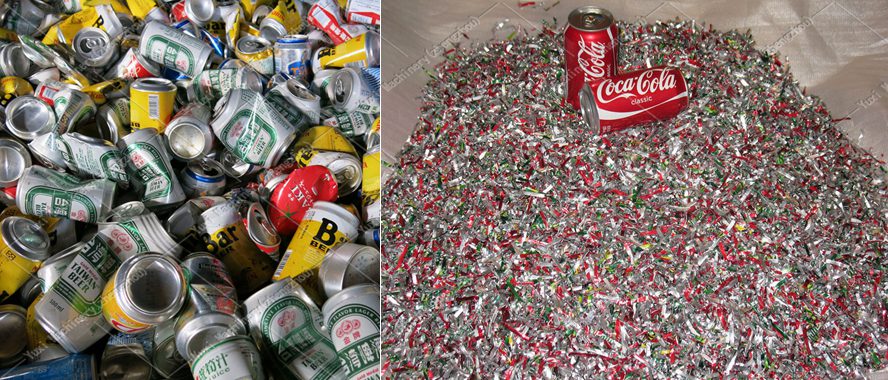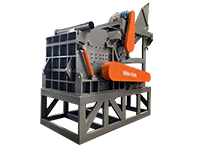Can crushers are essential equipment in modern waste management and resource recycling, using advanced shredding technology to efficiently reduce the volume of metal cans and enable resource recovery. This article provides an in-depth analysis of their working principles, application scenarios, technical parameters, and practical case studies, offering professional selection and application guidance for industry users.
Core Functions and Working Principles
Can crushers primarily reduce material volume through shear shredding principles:
• Dual-shaft shear system: Interlocking blades on two counter-rotating shafts shear and shred materials
• Graded shredding design: Blade spacing can be adjusted to achieve different particle sizes
• Automated control system: Equipped with intelligent monitoring to track current, temperature, and load in real time
Advanced models integrate magnetic separation and eddy current separation systems, enabling simultaneous separation of ferrous and non-ferrous metals during shredding, significantly improving recovery efficiency.

Applicable Material Range
Can crushers can process various material types:
1. Hollow containers: Beverage cans, plastic buckets, beer cans, metal drums, packaging boxes, etc.
2. Waste household appliances: TV casings, washing machine casings, refrigerator casings, etc.
3. Piping materials: Large pipes, pipe fittings, PE pipes, etc.
4. Waste templates: Wooden pallets, plastic pallets, forklift pallets, etc.
5. Used tires: Car tires, truck tires, etc.
6. Scrap metal: Car bodies, aluminum alloys, used cast aluminum parts, engine casings, lead, steel plates less than 0.2 inches thick
7. Other materials: Food waste, municipal solid waste, RDF derivatives, medical waste, biomass, garden waste, etc.
Technical Parameters and Selection Guide
Key parameters to consider when selecting a can crusher:
• Processing capacity: 110 lbs/h to 10 tons/h, chosen based on actual needs
• Motor power: 3 HP to 130 HP, affecting processing capacity and shredding fineness
• Blade configuration: Different thicknesses and tooth counts available for different materials
• Shredding particle size: Typically 0.8-4 inches, adjustable via blade spacing
• Dimensions and weight: From compact (4ft×2.6ft×5ft) to large (10ft×6.6ft×8.2ft)
Selection recommendations:
• Small restaurants/retail stores: 110-440 lbs/h models
• Medium-sized recycling centers: 1,100-2,200 lbs/h models
• Large industrial applications: 4,400-20,000 lbs/h models
Practical Application Cases
Food Service Industry Application
Case Study: An international fast-food chain deployed can crushing systems across 500 locations, achieving:
• 65% reduction in food waste volume
• 40% increase in revenue from metal recycling
• 38% reduction in waste disposal costs
The company established a sustainable waste management system using a "shred-recycle" centralized model.
Municipal Waste Treatment Center Application
Case Study: A municipal waste treatment center implemented a large-scale can crushing system, achieving:
• 98.5% metal recovery rate
• 52% reduction in landfill volume
• 22% reduction in operating costs
The system integrated magnetic and eddy current separation technologies for efficient recovery of iron, aluminum, and other metals.

Operation and Maintenance Guidelines
• Pre-start inspection: Verify proper blade installation, correct spacing, and adequate lubrication
• Operation monitoring: Watch for current fluctuations, abnormal noise, and discharge conditions
• Regular maintenance:
◦ Daily: Check blade wear, clear feed inlet
◦ Weekly: Check bearing temperatures, replenish grease
◦ Monthly: Check belt tension, adjust blade spacing
◦ Quarterly: Comprehensive inspection of all component wear
• Safe operation: Strictly follow operating procedures and ensure all safety guards are in place
Frequently Asked Questions
Can can crushers handle all types of cans?
Most models handle common metal cans, but note:
• Avoid materials exceeding feed inlet dimensions
• Drain cans with significant liquid content first
• Special materials or shapes may require custom models
How to handle shredded materials?
Two common approaches:
1. Metal recycling: Separate ferrous and non-ferrous metals using magnetic and eddy current separation
2. Waste disposal: Reduce volume for landfill or incineration, lowering disposal costs
What are the energy consumption characteristics of can crushers?
Energy consumption varies by model:
• Small models: 0.75-3 HP
• Medium models: 7.5-20 HP
• Large models: 25-130 HP
Actual energy consumption is approximately 7.5-30 kWh per ton of material processed.
How to ensure safe operation?
Safe operation practices include:
• Strictly follow the operation manual
• Ensure all safety guards are properly installed
• Conduct regular safety training
• Install emergency stop devices
• Avoid cleaning or maintenance during operation

Conclusion
Can crushers achieve both resource recovery and cost control through efficient shredding and intelligent separation technologies. Their applications range from food service to municipal waste management, continuously expanding.
Selecting the right model, optimizing operational processes, and implementing regular maintenance will help businesses improve efficiency while achieving sustainability goals. With technological advancements, intelligent and energy-efficient can crushers will become the mainstream direction for future development.
 Shredding Machine
Shredding Machine
 Waste Recycling Line
Waste Recycling Line
 Optional Equipment
Optional Equipment



